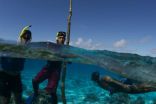(Press-News.org) NEW YORK (August 20, 2012)—A new study by researchers from the Global Change Institute at the University of Queensland, the ARC Centre of Excellence for Coral Reef Studies at James Cook University, and the Wildlife Conservation Society has found that locally managed marine protected areas within Fiji are playing an increasingly important role in the nation's strategy to protect inshore habitats.
The study estimates that by 2020, locally managed marine protected areas within the Fiji Locally Managed Marine Area (LMMA) network will effectively protect between 12-18 percent of all coastal and inshore marine habitats in Fiji. The authors conclude that through local, grassroots management alone, Fiji is on target to achieve approximately half of the national government goal to protect at least 30 percent of Fiji's inshore habitats.
The study appears online in the early view of the journal Conservation Letters. Authors include: Morena Mills of the ARC Centre of Excellence for Coral Reef Studies at James Cook University and Global Change Institute at the University of Queensland; Vanessa Adams, Robert Pressey, and Natalie Ban of the ARC Centre of Excellence for Coral Reef Studies at James Cook University; and Stacy Jupiter of the Wildlife Conservation Society.
This 'people power' approach will have substantially delivered on the Aichi Biodiversity Target – an international commitment by signatories to the Convention on Biological Diversity to effectively conserve 10 percent of the world's coastal and marine areas by 2020.
This locally focused approach to marine resource management is not limited to Fiji or the broader LMMA network, which also operates in Papua New Guinea, Solomon Islands, Indonesia, Palau, Pohnpei, the Philippines and Vanuatu. For example, in the Philippines, over 1,500 additional local marine protected areas have been established outside of the LMMA network. However, both Fiji and the LMMA network play a leading role in this movement.
"The results of the study are remarkable given that locally managed marine area networks in Fiji and the Western Pacific region are generally established only to meet local objectives, most notably to improve food security," says Dr. Morena Mills, lead author of the paper.
Yet, not all habitats are being protected equally, and some of the habitats that require the most protection, such as mangroves, intertidal mudflats, and coral reefs, still require stricter management. Full achievement of the national targets by 2020 will require additional incentives to protect these sensitive ecosystems. Such incentives could include cash payments and/or more subtle approaches, such as national public recognition, in exchange for protecting larger or more specific areas.
"Such incentives are critical," says Dr. Stacy Jupiter, Director of the Wildlife Conservation Society Fiji Country Program, "We cannot expect local communities to bear the full cost burden of contributing to national objectives."
INFORMATION:
WCS's work in Fiji has been made possible through the generous support of the John D. and Catherine T. MacArthur Foundation, The David and Lucile Packard Foundation, The Tiffany & Co. Foundation, the Flora Family Foundation, and the National Oceanic and Atmospheric Administration.
The Wildlife Conservation Society saves wildlife and wild places worldwide. We do so through science, global conservation, education and the management of the world's largest system of urban wildlife parks, led by the flagship Bronx Zoo. Together these activities change attitudes towards nature and help people imagine wildlife and humans living in harmony. WCS is committed to this mission because it is essential to the integrity of life on Earth. Visit www.wcs.org.
The MacArthur Foundation supports creative people and effective institutions committed to building a more just, verdant, and peaceful world. In addition to selecting the MacArthur Fellows, the Foundation works to defend human rights, advance global conservation and security, make cities better places, and understand how technology is affecting children and society. More information is at www.macfound.org.
In Fiji, marine protection gets local boost
2012-08-22
ELSE PRESS RELEASES FROM THIS DATE:
Better monitoring of food quantity makes self-control easier
2012-08-22
MINNEAPOLIS / ST. PAUL (08/22/2012) —New research from the University of Minnesota's Carlson School of Management suggests learning how to stop enjoying unhealthy food sooner may play a pivotal role in combating America's obesity problem. The research, published in the Journal of Consumer Research, explores how satiation, defined as the drop in liking during repeated consumption, can be a positive mechanism when it lowers the desire for unhealthy foods.
"When people talk about self-control, they really imply that self-control is willpower and that some people have it ...
Iowa State, Ames Lab researchers study the structure of drug resistance in tuberculosis
2012-08-22
AMES, Iowa – Edward Yu took note of the facts – nearly 2 million deaths each year, 9 million infected each year, developments of multidrug-resistant, extensively drug-resistant and now totally drug-resistant strains – and decided to shift his research focus to tuberculosis.
Yu, an Iowa State University and Ames Laboratory researcher, has described in the journal Nature the three-part structure that allows E. coli bacteria to pump out toxins and resist antibiotics.
And now, in a paper published online by the journal Nucleic Acids Research, a research team led by Yu describes ...
30 minutes of daily exercise does the trick
2012-08-22
Researchers at the University of Copenhagen have shown that 30 minutes of daily training provide an equally effective loss of weight and body mass as 60 minutes. Their results have just been published in the American Journal of Physiology.
Forty percent of Danish men are moderately overweight. For thirteen weeks, a research team at the Faculty of Medical and Health Sciences followed 60 heavy – but healthy – Danish men in their efforts to get into better shape. Half of the men were set to exercise for an hour a day, wearing a heart-rate monitor and calorie counter, while ...
Income, 'screen time' affect soda, junk food consumption
2012-08-22
(Edmonton) Preschoolers from low-income neighbourhoods and kids who spend more than two hours a day in front of a TV or video-game console have at least one thing in common: a thirst for sugary soda and juice, according to research from the University of Alberta.
Researchers from the faculties of Physical Education and Recreation, School of Public Health and Medicine & Dentistry surveyed parents to assess the dietary habits of 1,800 preschoolers in the Edmonton region as part of a larger study on diet, physical activity and obesity.
Researchers found that 54.5 per cent ...
Likely voters say president's 'first 100 days in office' should include plans for research
2012-08-22
WASHINGTON—August 22, 2012— On the eve of the political conventions, nearly two-thirds of likely voters say the next president should announce initiatives promoting medical progress during his "first 100 days in office," according to a new national public opinion poll commissioned by Research!America. And nearly three-quarters of those polled say it's important for candidates for the presidency and Congress to have a science advisor. The findings reveal deep concerns among voters about the lack of attention candidates and elected officials have assigned to research.
"Research ...
Ames Laboratory scientists crack long-standing chemistry mystery
2012-08-22
A team of researchers at the U.S. Department of Energy's (DOE's) Ames Laboratory has answered a key question concerning the widely-used Fenton reaction – important in wastewater treatment to destroy hazardous organic chemicals and decontaminate bacterial pathogens and in industrial chemical production. The naturally occurring reaction was first discovered in 1894 by H.J.H. Fenton, a British chemist at Cambridge, and involves hydrogen peroxide (H2O2) and iron.
How the Fenton reaction actually happens has remained in contention. Scientists have long debated whether it ...
Ancient fossils reveal how the mollusc got its teeth
2012-08-22
TORONTO, ON – The radula sounds like something from a horror movie – a conveyor belt lined with hundreds of rows of interlocking teeth. In fact, radulas are found in the mouths of most molluscs, from the giant squid to the garden snail. Now, a "prototype" radula found in 500-million-year-old fossils studied by University of Toronto graduate student Martin Smith, shows that the earliest radula was not a flesh-rasping terror, but a tool for humbly scooping food from the muddy sea floor.
The Cambrian animals Odontogriphus and Wiwaxia might not have been much to look at ...
UCI microbiologists find new approach to fighting viral illnesses
2012-08-22
Irvine, Calif., Aug. 22, 2012 — By discovering how certain viruses use their host cells to replicate, UC Irvine microbiologists have identified a new approach to the development of universal treatments for viral illnesses such as meningitis, encephalitis, hepatitis and possibly the common cold.
The UCI researchers, working with Dutch colleagues, found that certain RNA viruses hijack a key DNA repair activity of human cells to produce the genetic material necessary for them to multiply.
For many years, scientists have known that viruses rely on functions provided by ...
Australian general practitioners in training spend less time with peds patients than with adults
2012-08-22
Ann Arbor, Mich. — Australian doctors-in-training spend significantly less time consulting with pediatric patients than they do with adults, according to a new study published in the journal Australian Family Physician.
The study found that the proportion of longer consultations – more than 20 minutes -- for children was significantly less than that for adults and seniors among general practice registrars, says Gary Freed, M.D., M.P.H., the lead author on the study and Australian-American health policy fellow, Australian Health Workforce Institute at the University of ...
Close contact with young people at risk of suicide has no effect
2012-08-22
Researchers, doctors and patients tend to agree that during the high-risk period after an attempted suicide, the treatment of choice is close contact, follow-up and personal interaction in order to prevent a tragic repeat. Now, however, new research shows that this strategy does not work. These surprising results from Mental Health Services in the Capital Region of Denmark and the University of Copenhagen have just been published in the British Medical Journal.
Researchers from Mental Health Services in the Capital Region of Denmark and the University of Copenhagen have ...



